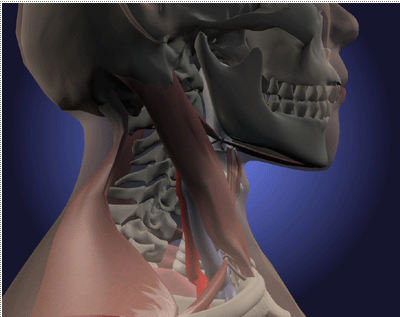| LEARNING OBJECTIVES
Skull
- Assemble the bony parts of
the skull into a framework for understanding how the head region is put
together: cranium/braincase, facial region, base of the skull,
throat skeleton.
- Use the relationship between
the three basal skull bones--ethmoid, sphenoid and temporal--to help
understand how that framework relates to special senses and cranial
nerves.
- Learn the bones of the skull
and their respective foramina, processes and regions including cranium;
face; orbit; nasal cavity; base of skull; throat region.
- Understand the structure,
development and function of the teeth, including dental formulas and the
change from deciduous to adult teeth.
- Appreciate the relationship
between the skull and cranial nerves and the brain
- Know where the special
senses, the various air and food passages, and all the muscles of the head
and neck region fit into the skull.
Pharynx/Throat
- Integrate the entry and exit
of food/water (respiratory and swallowing) with your understanding of the
anatomy of the mouth, nose, and throat regions.
- Illustrate the details of
the anatomy of the nasal, mouth, pharynx and larynx regions.
- Describe the structure,
function and location of the following: nasal cavity; pharyngeal
region; oral cavity; glands including salivary, thyroid, tonsils, tear;
muscles of tongue, chewing, facial expression.
- Understand sensory input and
motor output, via cranial nerves, to the mucous linings and muscles of the
nose, mouth and throat regions.
Special Senses
- Construct a robust understanding of the structures
involved in each special sense--smell, taste, vision and hearing--that
includes their detailed anatomy, how they function in interpreting the
input and transfering to their respective cranial nerves
- Understand the nasal epithelium including its
location and the role if its special smell-sensing neurons
- Know the kinds of taste sensations, where they are
located and which cranial nerves carry that information to the brain.
- Illustrate the role of the different eye support
structures including eyelashes, eyebrowns, eyelids, conjunctiva, tear
glands
- Explain the role of the extrinsic eye muscles
including their location, movements they cause and cranial nerves involved
- Construct a detailed model of the eye as an optic
device that explains how the component parts of the eyeball function
including sclera, choroid, iris, pupil, lens, ciliary body and muscle,
anterior and posterior segments, retina, cones, rods, optic nerve
- Analyze the importance of looking into the eye and
what can be seen at the back of the eyeball that might carry importance
for diabetes and melanoma.
- Trace the flow of sound from outside the body,
through the outer ear and middle ear to be interpreted in the inner ear.
- Know the functions of all of the components of the
physical parts of the ear including outer ear; middle ear chamber; middle
ear bones, muscles of the middle ear; ear drum, oval window, cochlea
- Describe the relationship between the temporal
bone, the labyrinth, the organs of balance and the cochlea of the inner
ear
- Understand how sound is translated into a neural
message and which cranial nerve carries that message
- Inventory the different components of static and
dynamic balance/movement sensing and how they work including the saccule,
utricle and three semi-circular canals
Cranial Nerves
- Construct overall view of control of all functions
of head/neck region--general sensory input, special senses, and motor
output to eye, tongue, jaw muscles, face and neck region
- Use the groups of cranial nerves--special
sensory nerves, somatic muscle nerves (eye, tongue), neck/rest-of-body
nerves; facial and trigeminal nerves--to organize your complete
understanding of the head/neck region and its various complex functions
- Know the general path of each cranial nerve and the
kinds of information--sensory and/or motor--and from what targets that
each nerve carries
- Appreciate the special role of the Vagus nerve
(Cranial Nerve X) as the principal parasympathetic innervation for most of
the body.
|
LAB
- Identify regions, bones, foramina, processes, and
other features of human skull (Lab Manual Exercise 4)
- Wish List for Skull
(word download)
- Bisect fetal pig heads to see nasal, mouth,
throat region and relationship between pathway for air and pathway for
food/water. View and compare same region on human cadaver. (In-Lab
Activity and Demonstration--handout
Word download)
- Anatomy of special senses with in-lab dissection
of sheep eyeball, experience with plastic models of special senses,
demonstration of eye, ear and nasal region on human cadaver and fetal
pig. (Lab Manual Exercises 14, 15 are guide)
-
Extrinsic
Eye Muscles--animation showing deficits
Lens
of eye--focus or accommodation animation
-
Wish List for Special Senses
(word download)
- Space Sickness and the Vestibular System (great
site for understanding balance) [link]
- Cranial nerve testing and function exercise using
own bodies as subjects--shows control of all functions of head/neck
region--general sensory input, special senses, and motor output to eye,
tongue, jaw muscles, face and neck region (Handout)
|


